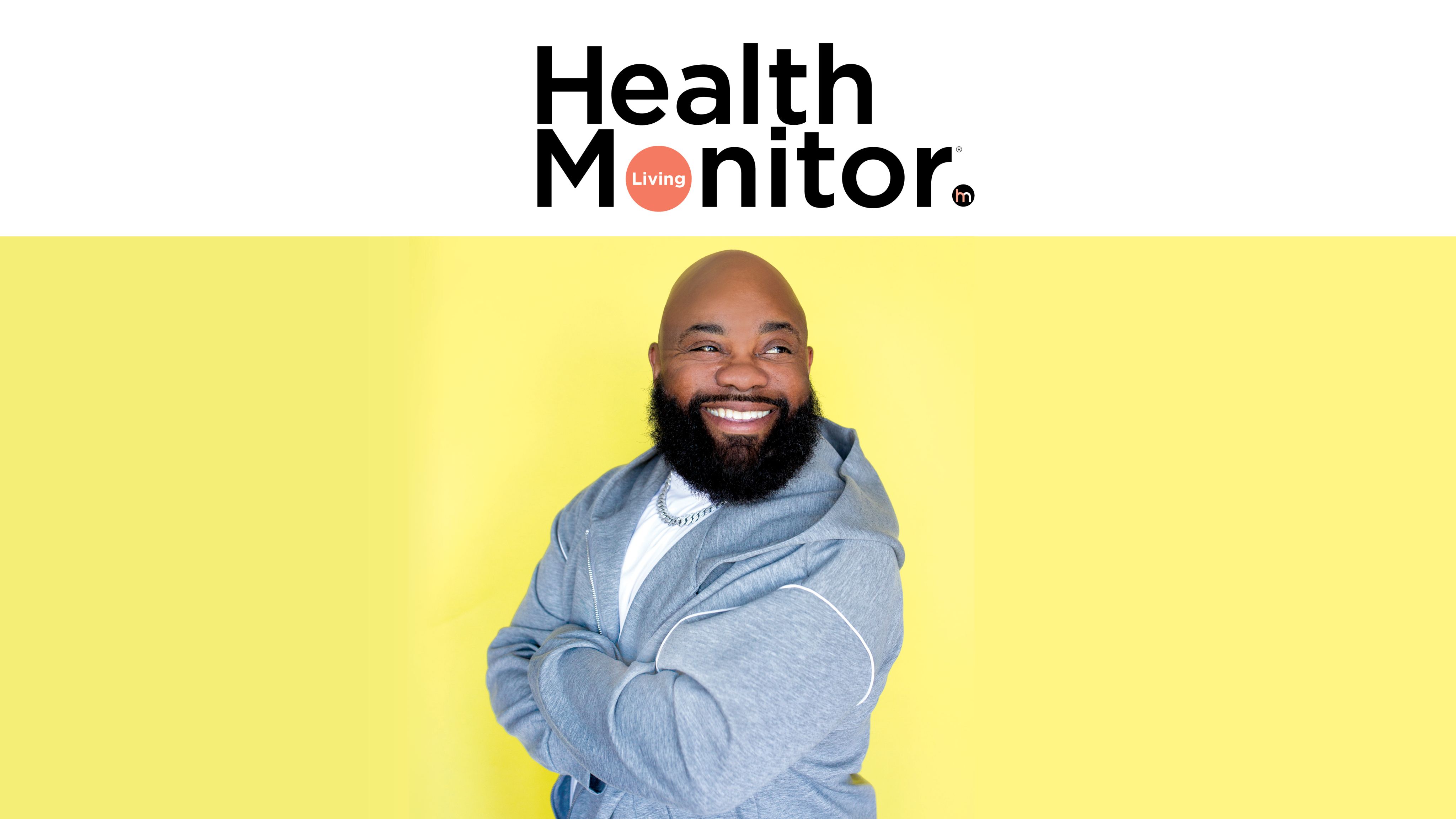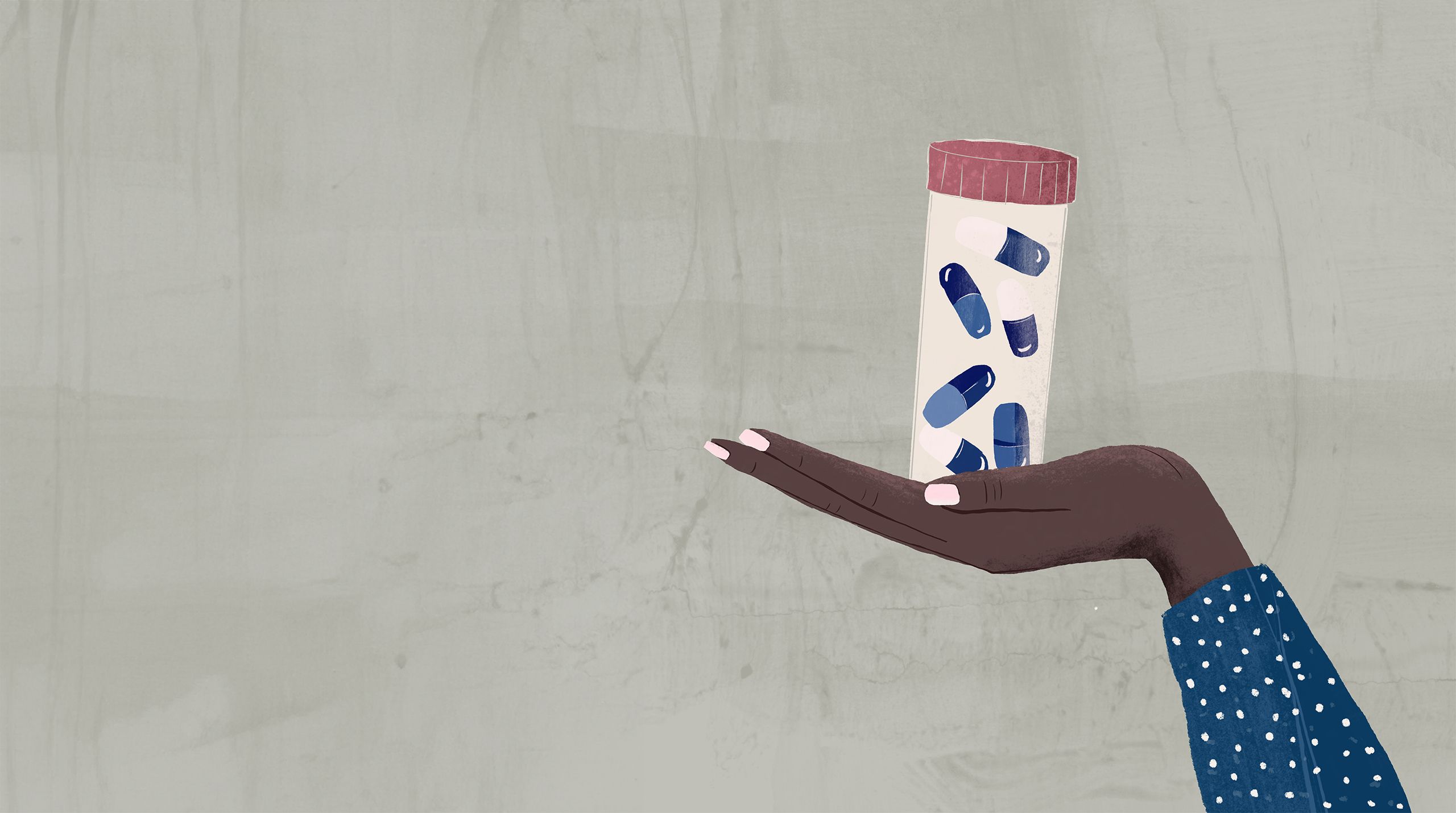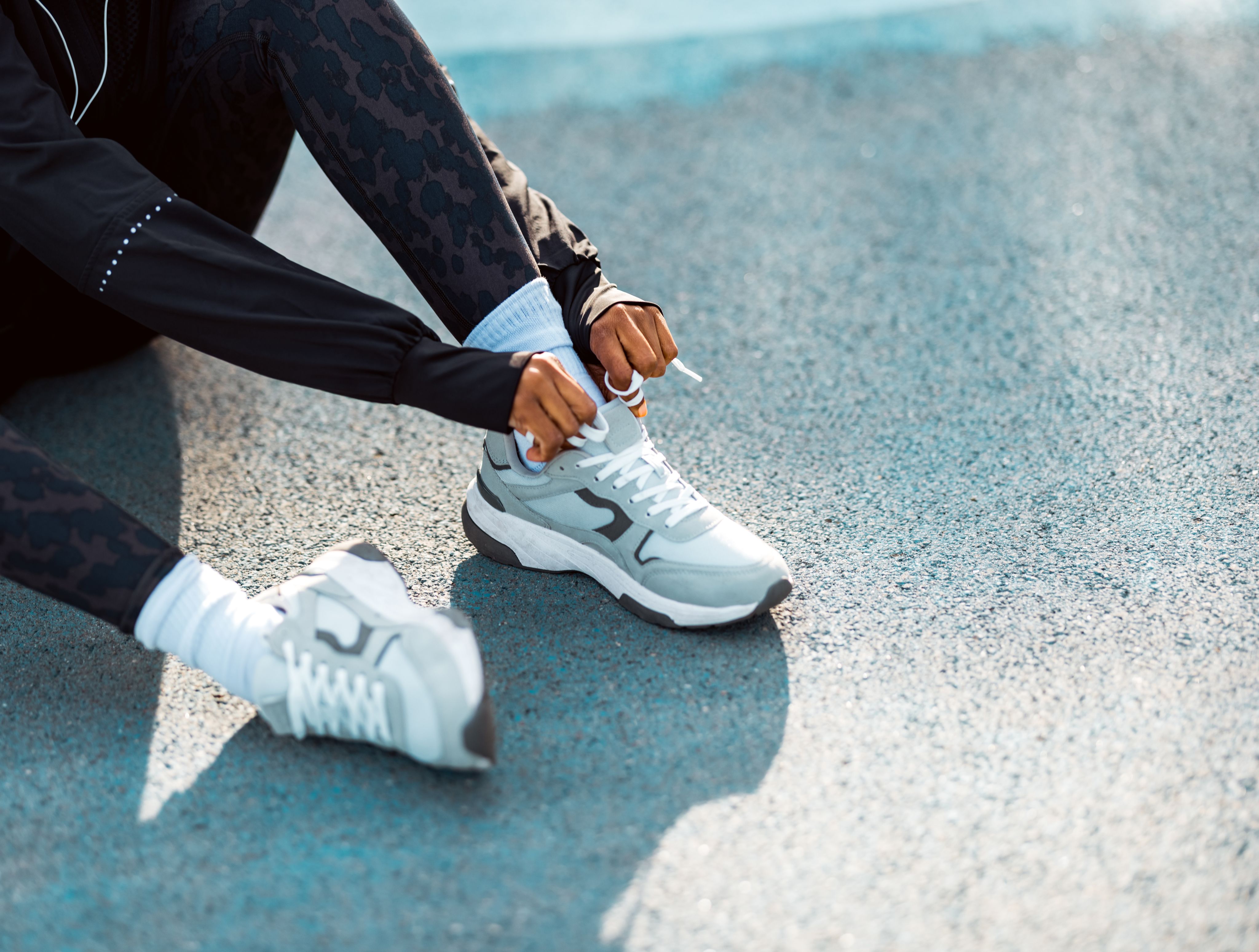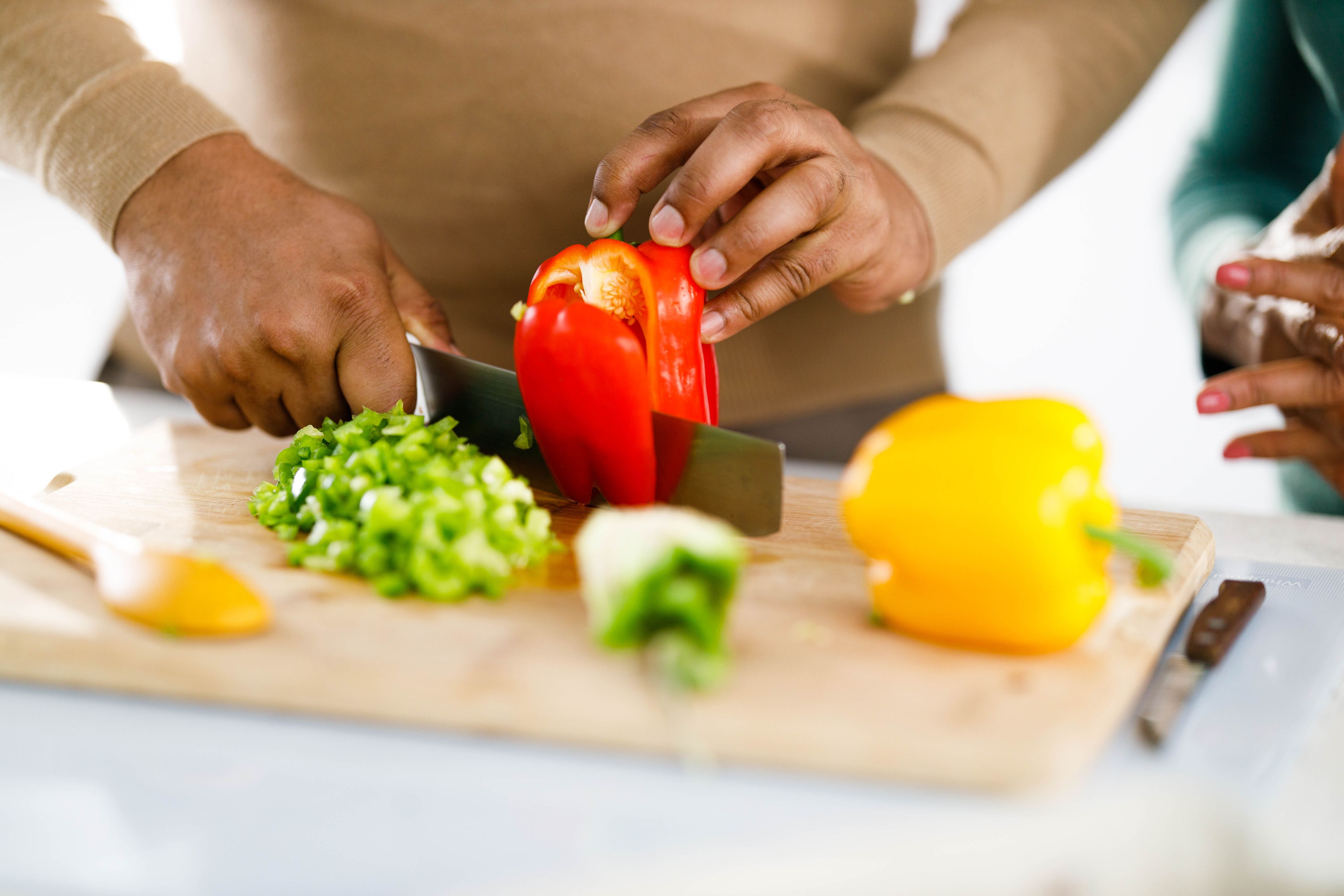“We’re setting
examples for
our communities!”
Diabetes

Live the life
you want!

Paid Advertiser
Paid Advertiser
Yes, you can keep doing all the things you love—despite diabetes! The key? Partnering with your care team and finding your best treatment plan.
A diabetes diagnosis can feel overwhelming. After all, it requires changing your eating habits, fitting in more physical activity and finding the right medication to control your blood sugar. And when it comes to diabetes’ impact on the Black community—not only are Black persons more likely to get the condition, but their outcomes are often worse than those of White persons.
Luckily there is good news: First, we understand diabetes—how it works in the body, risk factors, etc.—better than ever, and we have more treatment options than ever before. We also know that making small, positive changes every day is often the key to long-term success in managing the condition.
Just ask Earnest Johns, Jr., who finally transformed his health at the urging of his family. Now, after learning to choose healthier food options and by adding exercise and a new GLP-1 medication to his treatment plan, he’s lost 70 pounds, his blood sugar levels are under control and he feels better than he has in years.
Take a stand today!
No matter where you are in your diabetes journey, it’s not too late to get inspired by Earnest, as well as by Emmanuel Key, who shares the strategies that helped him turn his health—and his life—around. In this guide, you’ll find even more tools and tips that can help you along the way. But first, let’s take a closer look at diabetes, what it is and how it affects your body.
What is diabetes?
Diabetes is a group of metabolic disorders that are associated with a disruption in your body’s ability to produce or use insulin, which causes blood sugar levels to rise. Normally, beta cells, found in the pancreas, make insulin—the hormone that helps blood sugar enter cells to be used for energy. (Hormones are a natural chemical found in the body.)
In type 1 diabetes, beta cells are destroyed by the immune system, so the body does not make enough insulin. In type 2 diabetes, beta cells either don’t produce enough insulin and/or the body’s cells do not respond correctly to insulin (known as insulin resistance).
When blood sugar is unable to enter the body’s cells, it builds up in the bloodstream. Over time, excess blood sugar can lead to body-wide damage, including vision loss, heart disease, kidney disease and nerve damage.
Early symptoms of diabetes can include:
- frequent urination
- slow-healing wounds
- blurry vision
- fatigue
- increased thirst and hunger
- weight loss
- tingling in hands and/or feet
- very dry skin
- increased infections
Medicine can help
If you have type 1 diabetes, you will need to use insulin to treat the condition. If you have type 2 diabetes, oral medications, non-insulin injectables and/or insulin can help you manage your blood sugar levels. (See below for information on medication options for people with type 2 diabetes.)
What that means
Work with your diabetes care team to identify your blood sugar and A1C goals, and create an action plan to achieve them. Lifestyle changes are also important, so be sure to discuss those topics with your provider, as well.
Diabetes and the black community:
why awareness matters
Diabetes affects millions of Americans, but Black communities experience higher rates and more serious complications than other groups. In fact, Black adults are nearly 60% more likely to be diagnosed with diabetes and are at greater risk for complications like kidney disease, vision loss and amputations.
That’s why if you are a member of the Black community, it can be particularly important for you to:
- Get screened regularly: Ask your doctor about how often you should be tested for diabetes, especially if it runs in your family.
- Know the signs: Watch for symptoms like increased thirst, frequent urination or unexplained fatigue. (See above for additional symptoms.)
- Stay active: Aim for at least 30 minutes of movement most days of the week.
- Eat smart: Focus on whole foods—fruits, vegetables, lean proteins and whole grains—while limiting sugary and processed foods.
- Ask for support: Connect with local health programs, diabetes educators or community support groups.
- Speak up: Don’t hesitate to advocate for your health and ask questions about your care.
Fast facts:
Diabetes in the Black community
5
There are 5 million Black adults with diabetes—and many don’t know they have it!
60%
The rate of diabetes in Black persons is 60% higher than that of White persons.
3x’s
Black persons are 3 times more likely to be hospitalized for diabetes-related complications than White persons.
How medicines can help
The good news for people with type 2 diabetes? Today’s treatments can help you thrive! Ask your diabetes care team if these options are right for you.
Diabetes pills
Metformin decreases blood sugar made by the liver.
Oral glucagon-like peptide (GLP-1) receptor agonists increase insulin secretion, slow stomach emptying, and lead to reduced food intake and feeling full, with low risk of hypoglycemia (low blood sugar). An injectable form is also available.
Sodium-glucose co-transporter 2 (SGLT2) inhibitors promote the release of excess blood sugar through urine.
Dipeptidyl peptidase-4 (DPP-4) inhibitors prevent breakdown of a blood-sugar lowering compound.
Thiazolidinediones (TZDs) increase how your body responds to insulin.
Non-insulin Injectable Medicines
Glucagon-like peptide (GLP-1) receptor agonists increase insulin secretion, slow stomach-emptying time and lead to reduced food intake and feeling full, with low risk of hypoglycemia. An oral form is also available.
Glucose-dependent insulinotropic polypeptide (GIP)/GLP-1 receptor agonist combinations include GIP, a hormone that stimulates insulin secretion in response to food, which works in tandem with the GLP-1 to help your body better manage your blood sugar levels.
Insulin Injections
Insulin helps your body take up blood sugar into cells and helps the liver to store sugar.
Basal, or long-acting, insulin is typically taken once a day and acts slowly over 24 hours.
Bolus, or rapid-acting, insulin is taken before meals to prevent blood sugar increases after eating.
Combination Injectable Medicines
Insulin and GLP-1 agonists can be combined in a fixed-dose pen. The insulin helps keep blood sugar levels within target range, while the GLP-1 agonist helps the pancreas release insulin after eating.
Trouble remembering your meds? Use the calendar on your phone or tablet to keep track of them, as well as healthcare appointments and tests. Even better, synchronize your calendar with your loved ones to keep you both up-to-date.

Paid Advertiser
Paid Advertiser
“We’re setting examples
for our communities!”

Paid Advertiser
Paid Advertiser
After years spent ignoring their health, Earnest Johns, Jr., and Emmanuel Key were blindsided by their diabetes diagnoses. Today they’ve overhauled their lifestyles, gotten their blood sugar levels in goal and are determined to help the other members of their community take control of their futures.
—by Diane Herbst
“Yes you can turn your health around!”
____________________
EARNEST JOHNS, JR., 57
Earnest Johns, Jr., is not a man who takes life lying down. For one, he often works 10-hour days at an Amazon warehouse near his Lee Summit, MO, home—sometimes walking upwards of 15 miles a shift. In his off hours, when he’s not earning money on the side driving for Uber, he works out at his home gym three times a week and plays with his young grandchildren, who visit often.
“I feel like I am 21, I feel great,” says the 57-year-old married father of four adult children and grandfather of eight. “I have a lot of energy—I have to, with my schedule!”
About 17 years ago, however, Earnest felt dramatically different. Unusually fatigued, with the frequent need to urinate, “I wasn’t myself,” he says. After driving to a local hospital emergency room, tests revealed his blood sugar was at a dangerously high level of 720 mg/dL (a normal fasting blood sugar level for someone without diabetes is between 70 and 99 mg/dL, between 100 and 125 mg/dL indicates prediabetes and a level of 126 mg/dL or higher indicates diabetes), and he was diagnosed with type 2 diabetes. “They said, ‘I’m not sure how you drove yourself here with a blood sugar that high, most people are in a coma,’ ” Earnest recalls.
“I resisted the diagnosis”
Doctors wanted to admit him to the hospital to stabilize his blood sugar, but he refused. “I was in denial, I guess,” says Earnest. “And I didn’t want to stay overnight in a hospital. I told them just give me my meds—I’ll handle it.” After seeing his doctor and starting on metformin and another diabetes medication, Earnest needed to take a 30-day medical leave from his job at the time until his blood sugar stabilized.
Still, despite taking the medications, Earnest wasn’t ready to change his lifestyle. “I was enjoying life and having fun,” he says. “I didn’t want to stop drinking and stop eating and doing all that stuff.”
Earnest also felt a lingering anger and shame about the diagnosis. “There’s a stigma that diabetes is for overweight people who don’t take care of themselves. And I felt that wasn’t me,” he says. “I didn’t tell anyone but my immediate family.” Although Earnest’s mother and two sisters had diabetes, “we didn’t talk about it,” he says. “I didn’t know what managing it really meant.”
“I needed a change!”
Over the years, Earnest took the diabetes medications his doctor prescribed, but his A1C (a measure of average blood sugar levels from the previous three months) fluctuated between highs of 12.1% to about 8% (an A1C of less than 5.7% is considered normal, 5.7% to 6.4% indicates prediabetes and 6.5% or higher indicates diabetes). “I didn’t know any better,” he says. “I’d get hungry and I’d eat Frosted Flakes for breakfast thinking it’s something light—not thinking of all the sugar—or I’d eat the stuff I grew up on, fried chicken and mac and cheese or ribs with a side of coleslaw.”
It wasn’t until about five years ago when Earnest finally received the motivation he needed to make healthy lifestyle changes. His oldest son, Miguel, decided to develop an app using artificial intelligence (AI) to highlight Earnest transforming his life, to give others with diabetes hope and ideas to make positive changes for themselves. But to do it, Earnest had to participate. “I think that his goal was more to help me get better than to develop an app,” Earnest says.
So he dove into learning about how to eat a healthier diet, and started logging everything he ate. “In my culture, the African-American culture, on a Saturday or Sunday morning, mom is making biscuits and grits and eggs and bacon and sausage with toast, jelly and butter and the whole works,” he says. “Instead of all that, I switched to a couple of scrambled eggs with one piece of toast and some fruit or some whole grains.”
He swapped the fried chicken and mac and cheese for vegetables and healthy proteins, joining a delivered meal plan to ensure he received the right amount of healthy protein and carbohydrates when he ate. He also started walking and working out in the gym regularly.
Also around that same time, Earnest’s doctor—seeing that his blood sugar levels still weren’t at goal range—prescribed Earnest with a GLP-1 receptor agonist. “He said it seemed like a good fit for me, so I agreed to try it.”
“I felt better than I had in years!”
The combination of Earnest’s lifestyle changes and the new medication led to his A1C dropping to 6.8%—a record low for him! And as an added bonus, he also lost 70 pounds, a journey he has shared on Instagram @pops_t2d.
“My doctor trusts me. He’s seen the progress,” says Earnest. “I’ve had setbacks, like back surgery that required steroids that spiked my sugars—but I got back on track by adjusting my meds, diet and workouts. I am way more educated on diabetes now. I’ve learned what spikes my blood sugar or makes it go low. My body talks to me.”
And Earnest opening up about his diabetes journey now has colleagues at Amazon turning to him for advice. “If someone gets diagnosed, they’ll come and say, ‘Hey, aren’t you the diabetes guy? This is what happened. I just got diagnosed,’ ” he says. “I love helping people. Diabetes had been my secret. Now, I see it as my story. I didn’t want this diagnosis, but it’s made me stronger, wiser and much more connected—to myself, to my family and also to people going through the same thing.”
Make changes by finding your why
Earnest’s two sisters and mother all had type 2 diabetes and struggled with their weight. They also didn’t exercise or eat healthy diets. “That’s why when I first got diagnosed, I didn’t understand the importance of changing your eating habits,” he says. “They never did it, so why should I?” All three passed away from diabetic complications.
“That was a wake-up call. They just never really took care of themselves,” he says. “I’ve experienced so much loss because they ignored their health.”
When Earnest finally embraced that he needed to make changes, he found a major motivator: wishing to remain healthy for his children and grandchildren. “I want to see my grandchildren graduate high school. I want to see them get married, all of that. That’s my number one motivator,” he says.
Looking for sources of motivation yourself?
Staying healthy for family is a great starting point, and you can also be inspired by these reasons:
- Increasing your quality of life in later years
- Reducing symptoms of stress, anxiety and depression
- Boosting self-confidence
- Preventing complications like heart disease, vision loss and kidney disease
- Improving your sleep quality
- Having more energy for hobbies and daily tasks
- Reducing medical costs by avoiding preventable health issues
Photo by The Grays Photography
Photo by The Grays Photography
“I didn’t want this diagnosis,
but it’s made me stronger, wiser
and much more connected—
to myself, to my family and also to people going
through the same thing.”
Photo by E. A. Smith
Photo by E. A. Smith
Photo by E. A. Smith
Photo by E. A. Smith
“Embrace the power of change!”
____________________
EMMANUEL KEY, 61
In 2015, Emmanuel Key was diagnosed with diabetes after his vision rapidly changed. “It was a metabolic nightmare. My A1C (a measure of blood sugar levels from the past three months) was 9.8% (a result of 5.7% or less is considered normal, 5.7% to 6.4% indicates prediabetes and 6.5% or higher indicates diabetes), my liver enzymes were elevated and my kidney enzymes were elevated,” says the now-61-year-old. “I was a walking time bomb and had no idea.” The news terrified him. “I had family members who had diabetes, and I saw some of the struggles they had,” he says.
The catalyst that really pushed Emmanuel to make immediate changes? As the owner of a medical device distribution company, he had worked with vascular surgeons helping them with a device during operations. “I have been to cases where I’ve seen amputations. I’ve seen toes taken off. I’ve seen half a foot taken off. I’ve seen legs taken off,” he says. “I was acutely aware of the devastations of diabetes. To be honest, I totally freaked out and said, ‘I can’t go out like this.’ I got scared straight, so to speak.”
Emmanuel immediately started a medication to lower his blood sugar and he revamped his diet—six months later, his A1C had dropped to a low of 4.9%. Now, for the last seven years, he has maintained an A1C of 5.4% through continuing to stick to a healthy diet and exercise plan.
Turn your health around, like Emmanuel did!
Zero in on nutrition. “Based on my individual needs, I try to keep my carb intake to a max of 30 grams a day. I focus my diet on vegetables, fruit and protein,” says Emmanuel, a married father of three adult children. “I stay away from bread, sweets, candies, cakes and pastas. When I have carbs, I try to stick to whole grains like brown rice and maybe quinoa. And with veggies, I go heavy on the green leafy ones—they are key because they also help with blood flow.”
Find support to carry you through. Emmanuel became a lifestyle coach for 15 Black men as part of a year-long study by the Centers for Disease Control and Prevention to raise awareness about diabetes. “The best part about that is I started with 15 Black men and finished with 15 Black men, which in and of itself is a success—they actually stayed with it for a year,” he says. The goal of the program was for the men to lose between 5% and 7% of their body weight and to get 150 minutes of physical activity per week. Collectively, they lost about 300 pounds. “The secret sauce was simple,” Emmanual says. “We met on Zoom once a week for six months, and then the second six months, we met every other week. The men were able to come together and talk freely and were allowed to be vulnerable.” He says it created a no-judgment zone where the men found strength connecting with others who had similar struggles and goals.
Start with small steps. “You definitely want to get moving. You don’t necessarily have to have a gym membership, and you don’t have to start running,” Emmanuel says. “I had one guy in my group—he was 385 pounds; he’s down to 350. One of the things he would say to me was, ‘Coach, I didn’t really do much this week. I’ve been running around doing laundry, going to the grocery store, just doing errands.’ And I said, ‘Count that as physical activity because all I really care about is that you move.’ You start to see that’s all it takes. It could be 10 minutes in the morning, 10 minutes for lunch, 10 minutes after dinner. It doesn’t have to be all 30 minutes at one time. But the point is to move.”
Tap into activities you love. Once he was diagnosed with diabetes, Emmanuel—who had already enjoyed running—increased his physical activity and started doing 5K races regularly. And he starts each morning with 15 minutes of yoga. “I’m stretching, doing all that kind of stuff just to get the blood flowing. But it’s a way of just moving and keeping your flexibility,” he says. “You’ve got to move because by moving, you burn the carbs off.”
Connect with a partner. “The guys in the group and I had a little text thread going,” Emmanuel says. “If I went out in the morning and I got my three miles in, I would upload my Nike Run result into the thread, and then the other guys would start throwing theirs in, too.” It became like a competition with everyone sharing their achievements. “Accountability is what kept us going. One of the members actually lost so much weight, he had to get all of his suits tailored.”
Educate yourself. Emmanuel recommends an online diabetes educational program called The Healthy Goat. “What’s cool is it’s totally interactive and it gives you feedback,” he says. “You can set up how you want to do your plate. You can enter chicken, vegetables, and starchy and nonstarchy vegetables, for example. It’ll tell you how many carbohydrates are on that plate, and you can pull things off and play around with it.”
Q&A
Answers to your top questions about diabetes

Paid Advertiser
Paid Advertiser

OUR EXPERT
Rachel Pessah-Pollack, MD, FACE
Clinical Professor, Division of Endocrinology, Diabetes & Metabolism, NYU School of Medicine, NYU Langone Health
When should I start preventive measures?
Q: I’m a 30-year-old Black man, and my mom and her two siblings have type 2 diabetes. My physician told me that genetics can play a role in whether I’m diagnosed, as well. Is there anything I can do to prevent myself from getting the disease?
A: Having a first-degree relative (e.g., your mom) with type 2 diabetes increases your risk by up to 2 to 3 times—even more if both parents have it. And certain racial and ethnic groups in the U.S. are at higher risk of diabetes, e.g., 16.8% of Black people are diagnosed with type 2 diabetes vs. 11.2% of non-Hispanic White people.
Visit your physician regularly and know your fasting glucose and A1C levels. Normal fasting glucose is <100 mg/dL, impaired is 100–125 mg/dL and type 2 diabetes is indicated at 126 mg/dL or higher. Diabetes is also diagnosed with a three-month average of recent glucose levels (your A1C): 5.7% to 6.4% is considered prediabetes, and 6.5% or greater is consistent with diabetes. A1C readings in certain ethnicities, including Black people, can be inaccurate. Speak with your healthcare provider to see if this is the best test for you.
Lifestyle changes can help reduce your risk. Focus on lower-carb, balanced meals that have healthy fats and proteins. Avoid sugary drinks and stay hydrated with water. Aim for at least 150 minutes of moderate-intensity or 75 minutes of vigorous-intensity aerobic exercise a week. If you have obesity or are at a higher weight, try to maintain sustainable weight loss. If you’re struggling, dietitians or personal trainers can help you reach your goals.
Changing your tastes
Q: Since I was a kid, I’ve always had a general distaste for “healthy” foods, especially fruits and vegetables. Is there any way to change this?
A: It sounds like a lot of your feelings about food have been with you since childhood. Experimenting may lead you to try foods that could become new favorites—for instance, cauliflower rice as a low-carb substitute for regular rice, or zucchini noodles prepared with your favorite pasta sauces. Some registered dietitians specialize in helping people work through food aversion issues, so it may be worth seeking one out.
Resources you can rely on
Looking for places you can trust for
information and care? Check these out…
Seeking more information about diabetes?
- American Diabetes Association
- American Association of Clinical Endocrinology
- American Association of Diabetes Educators
- National Institute of Diabetes and Digestive and Kidney Diseases
Need help with payment assistance?
Looking for a new provider?
Looking for transportation services?
Looking for a support group?
Stay on your toes with these foot-friendly moves!

Paid Advertiser
Paid Advertiser
If you have diabetes-related neuropathy, your feet may bear the brunt of it. The nerve condition can cause burning pain and loss of feeling, make you prone to foot sores and impair your ability to walk properly. Luckily, physical therapist Frank Musumeci, founder of Prescription Exercise, a preventive orthopedic fitness clinic in Miami, says giving your feet some TLC can help keep them in top shape.
KEEP YOUR FEET FLEXIBLE
If you have to wear tight or pointy shoes—say, for a dressy occasion—try this stretch before and after the event:
Sit down, place your feet side by side and loop a thick elastic band around your big toes. Slowly pull your big toes apart to gently stretch the ligaments and joints. Hold for 10 seconds; repeat five times.
Don’t do this: Wear heels over two inches. Anything higher puts too much pressure on your forefoot, especially the big toes.
LOOSEN YOUR ANKLES
To prevent pain, the bones between your ankle and shin need to glide easily over each other. This move can help:
Sit on a chair, raise one foot slightly off the floor and “write” each letter of the alphabet with your big toe. Repeat with the other foot. If your ankle doesn’t have full range of motion, physical therapy can help restore movement.
STRETCH YOUR CALVES
Flexible calves provide a stable base, helping you to walk more efficiently and preventing falls. Stretch after a shower, when your muscles are warm and pliable. Two exercises to try:
Wall stretch:
Lean against a wall, hands flat, with your left foot forward and right foot back. Keep both heels on the floor and press your hips forward, feeling the pull in your right calf and Achilles tendon. Hold for 30 seconds, then switch sides. Repeat three or four times.
Towel stretch:
Sit on the floor with both legs out in front of you. Loop a towel around the ball of one foot and pull the towel toward you, keeping your leg straight. Hold for 30 seconds, then switch sides. Repeat three or four times.
Cushion your landings
For everyday wear, opt for shoes with a rubber sole and a wide toe box. The shoe should also bend at the ball of your foot where you push off, not in the middle.
Easy footwear test:
If you can fold the shoe in half, skip it.
Tip! Always check your feet daily for ulcers or cuts and make sure to avoid walking barefoot.
Illustrations by Juhee Kim
Sneaky reasons your blood sugar is...
High
1. You skipped breakfast.
Bolting out the door without eating in the morning can mean higher blood sugar the rest of the day. Studies suggest that when you skip breakfast, you’re likely to experience hyperglycemia (high blood sugar) after lunch due to decreased insulin and GLP-1 secretions. This impaired glucose regulation may extend to later meals as well, contributing to higher blood sugar levels.
Try this! Prep blood sugar-friendly breakfast options on the weekend and freeze for time-crunched weekday mornings.
2. You eat a high-fat diet.
Regular high-fat meals can cause blood sugar to rise in two ways: First, high-fat meals result in more free fatty acids in your blood, causing insulin resistance and difficulty moving blood sugar into cells. Second, fat slows the release of blood sugar, so insulin can be done working before blood sugar even builds in the blood.
Try this! Stay away from fast food because fried fare has a high amount of saturated fats. Instead, try packing a lunch or meal prepping whenever you can so you have full control of the nutrients in your meal.
3. You haven’t slept enough.
Feeling tired can cause you to reach for food—and in particular comfort food—more often than you would if you were rested, which may lead to high blood sugar levels. Plus, not getting enough rest can trigger a rise in blood sugar-raising stress hormones.
Do this! If you often fall short on the amount of sleep you need—and you don’t see a solution to that right now—ask your doctor if timing your insulin or oral medication could help.
4. You got sick.
Coming down with the flu, a cold or other illness triggers the release of stress hormones that lower your body’s ability to use insulin, so blood sugar rises.
Do this! Monitor your blood sugar more often while you’re sick and drink water to stay hydrated and flush blood sugar through your system. Check with your diabetes care team to see if you need to adjust your meds.
Low
1. You used too much insulin/medication.
Taking more insulin than you need can cause your blood sugar level to drop too low, which can cause hypoglycemia. Signs include shakiness, anxiety, sweating, chills, clamminess, nausea, confusion and rapid heartbeat.
Do this! Eat a source of quickly absorbed sugar—aim for 15–20 g of carbs, such as 5–6 oz of orange juice, 6 Hershey Kisses or 15 Skittles. (If you prefer glucose tablets, check the nutrition info on the label, as the amount of carbs varies by brand.) Then work with your diabetes care team to find the right dosage and schedule to fit your diet and activity habits.
2. You took a hike—but didn’t plan for it.
Your muscles use glucose (sugar) in your blood during exercise and activities like yard work or housecleaning, causing blood sugar levels to fall. If you don’t eat enough to cover your activity, your levels can drop too low.
Try this! Set a time on your watch to remind you to stop and have a snack, and keep portable snacks handy when away from home.
Be on guard for: Hypoglycemia unawareness, which is when you don’t feel any symptoms (such as shakiness, sweating and nausea) when your blood sugar drops below 70 mg/dL. If this happens, ask your care team if changing your blood sugar targets could help you avoid future episodes or if you might be a candidate for a continuous glucose monitor.
3. You drank (alcohol) more than you ate at a party.
Alcohol can cause your body to release too much insulin, causing severe low blood sugar. Drinking alcohol on an empty stomach can heighten this impact, since your liver is working on removing the alcohol from your blood instead of managing blood sugar levels.
Try this! Test your blood sugar before and up to 24 hours after drinking and have a snack if you find it’s low. It’s also important to limit your alcohol intake to one drink a day for women and two drinks a day for men.

Make your next potluck diabetes-friendly!

Potlucks—whether for a church picnic, work party or holiday celebration—can be a fun way to gather with family and friends, but the heavy casseroles, mac n’ cheese and desserts people typically bring can also spell trouble for your blood sugar levels. Luckily, sticking to your diabetes management plan doesn’t mean you have to miss out on the fun. By bringing your own healthy (but tasty!) dish, you can rest assured you’ll have at least one option to tuck into, and you can use these tips to navigate the rest of the buffet table, too.
—by Constance Brown-Riggs,
MSEd, RDN, CDCES, CDN
Avoid impulse selections. If you often find yourself heading to a potluck with the best of intentions, only to have your resolve crumble once you’re facing the casseroles, chances are you’re arriving too hungry. Try having a protein-packed pre-event snack next time, such as a handful of trail mix, a hard-boiled egg or some hummus and veggies, which will help you feel full and less inclined to indulge.
Do a walk-through. Before putting any food on your plate, walk around and just look at all the selections. That way, you can budget room for the foods you really want to try rather than taking heaping spoonfuls of everything you see.
Remember, nothing is off the table… even if you’re living with diabetes. That means if you really want a taste of your Aunt Susan’s chocolate pudding pie—have some! The trick is, only take three bites, and chew as slowly as you can. That will act as a reminder to truly savor the food, and it will also help you tune into feelings of fullness. More often than not, you’ll find you’re satisfied after the three bites, so you won’t even feel tempted to go for seconds.
Add activity. Rather than planting yourself at a seat for the duration of the party, make a point to get up, walk around and mingle at least once an hour. Studies show that regular, small bouts of activity throughout the day are actually better at helping your body maintain steady blood sugar levels than just doing a single longer workout session once a day. Plus if you’re busy chatting, you’ll be less tempted to revisit the dessert table!
Bring this!
Chicken Creole Sheet Pan Dinner
Makes 8 servings
When it comes to any food-centric gathering, one surefire method to make sure you leave satisfied and guilt-free is by bringing a dish you know you can fill your plate with—and that’s also tasty enough to win oohs and aahs from the other partygoers. That’s what Constance Brown-Riggs, MSEd, RDN, CDCES, CDN, had in mind with this crowd-pleasing recipe that just so happens to be low in calories, fat and carbs—but not in flavor!
INGREDIENTS
- 3 lb skinless, boneless chicken thighs, cut into 2" pieces
- 4 Tbsp Creole seasoning
- 4 zucchini
- 2 red bell pepper
- 2 red onion
- 2 lb green beans, trimmed
- 4 Tbsp olive oil
Directions
- Preheat oven to 375°F. Rub chicken pieces with 2 Tbsp Creole seasoning and let stand while you prep other ingredients.
- Chop zucchini, pepper, onion and green beans into 2" pieces and combine with chicken. Toss with olive oil and remaining seasoning and spread evenly on a lined sheet pan.
- Bake for about 20 minutes or until chicken is cooked through with internal temperature of 165°F.
Nutrition facts (per serving)
Calories 346; fat 14.8 g (sat. fat 3 g); cholesterol 136 mg; sodium 162 mg; carbohydrates 16 g; fiber 5 g; sugars 9 g; protein 38 g.

6 ways to keep your vision clear!

If you have diabetes, you know that high blood sugar can affect your entire body, including your eyes. In fact, diabetes is the leading cause of blindness in adults, according to the Centers for Disease Control and Prevention. In addition to aiming for your target A1C, minimizing blood sugar spikes and dips and getting regular exams, try these strategies:
1. Stub out cigarettes.
Not only does smoking make it more difficult to control blood sugar, research shows that smokers have double the risk of developing cataracts than nonsmokers, and heavy smokers (15 cigarettes/day or more) have three times the risk! If you smoke and are having trouble quitting, ask your doctor about smoking cessation treatments and consider joining a support group to learn techniques that can help kill the cravings.
2. Slash stress.
Anxious jitters do more than just frazzle your nerves; stress can also raise blood sugar and blood pressure, both of which may damage blood vessels in the eye. In fact, a study published in the American Journal of Ophthalmology found that chronic stress is a risk factor for developing glaucoma. So whenever you feel overwhelmed, turn to your favorite soothing technique.
3. Sport shades.
People with diabetes are at a greater risk of cataracts because consistently high blood sugar causes blood vessels in the eyes to swell and accelerates the thickening of your eyes’ lens, according to the American Diabetes Association. Since direct exposure to UV light is another contributing factor, be sure to wear sunglasses every time you go outside, rain or shine. Choose a pair that blocks 100% UVA and UVB rays.
4. Deflate high blood pressure.
Untreated high blood sugar can lead to diabetic retinopathy (DR), in which blood vessels in the retina get damaged. Fortunately, studies have found that getting blood sugar levels to a normal level reduces the risk of developing DR. Your healthcare provider may recommend adding a medication to reduce blood pressure and making lifestyle changes such as increasing activity and eating a healthy diet.
5. Ramp up your heart rate.
Aerobic activities like walking, biking and dancing can help keep eyes healthy by reducing pressure on the nerves in the eye. In addition, exercise can lower high blood sugar levels, cholesterol and blood pressure, all of which can contribute to eye disease. Research published in Microvascular Research found that those who get regular moderate intensity exercise can keep DR from progressing.
6. Get hooked on fatty fish.
Fish that is rich in omega-3 fatty acids, such as salmon, tuna, mackerel, halibut and sardines, may protect against DR by preventing inflammation and abnormal blood vessel growth in the eyes. In fact, a study published in Experimental Eye Research suggests that consuming 1,000 mg per day of omega-3s (that’s four servings a week of fatty fish) can lower the risk of DR.
The best protection?
Regular eye exams!
Often, symptoms don’t appear until a disease has progressed. Having regular eye exams is the best way to catch eye disease early.
Quiz

Special thanks to our medical reviewer:
Asem H. Ali, MBBS, FACE, DABOM, DABCL,
Assistant Professor of Medicine, Chobanian and Avedisian School of Medicine,
Boston University, Boston Medical Center
Lindsay Bosslett, Vice President, Editor-In-Chief; Joana Mangune, Editorial Manager; Amanda Prost, Editor; Sara Rotondi, Associate Editor; Debra Koch, Senior Copy Editor; Maria Lissandrello, Editor Emeritus; Erica Kerber, Vice President, Creative Director; Suzanne Augustyn, Senior Art Director; Kimberly H. Vivas, Senior Vice President, Production and Project Management; Rachel Pres, Senior Director, Digital Production
Dawn Vezirian, Senior Vice President, Financial Planning and Analysis; Tricia Tuozzo, Senior Manager, Client Solutions, Key Accounts; Augie Caruso, Executive Vice President, Sales and Key Accounts; Keith Sedlak, Executive Vice President, Chief Commercial Officer; Howard Halligan, Chief Financial Officer; David M. Paragamian, Chief Executive Officer
Health Monitor Network is the nation’s leading multimedia patient-education company, with websites and publications such as Health Monitor®.
For more information: Health Monitor Network, 11 Philips Parkway, Montvale, NJ 07645; 201-391-1911; healthmonitornetwork.com ©2025 Data Centrum Communications, Inc. Questions? Contact us at customerservice@healthmonitor.com
This publication is not intended to provide advice on personal matters, or to substitute for consultation with a physician.
LUJ25-DG-TD-1EZOAA
Health Monitor Medical Advisory Board
Michael J. Blaha, MD, Director, Clinical Research, Ciccarone Center for the Prevention of Cardiovascular Disease; Professor of Medicine; Johns Hopkins
Leslie S. Eldeiry, MD, FACE, Clinical Assistant Professor, Part-time, Department of Medicine, Harvard Medical School; Department of Endocrinology, Harvard Vanguard Medical Associates/Atrius Health, Boston, MA; Chair, Diversity, Equity and Inclusion Committee, and Board Member, American Association of Clinical Endocrinology
Cheri Frey, MD, Assistant Professor, Dermatology, Howard University; Chair, Dermatology Section of the National Medical Association
Marc B. Garnick, MD, Gorman Brothers Professor of Medicine, Harvard Medical School; Director, Cancer Network Development, Beth Israel Deaconess Medical Center; Editor-in-chief, Harvard Medical School’s Annual Report on Prostate Diseases
Angela Golden, DNP, FAAN, Family Nurse Practitioner, former President, American Association of Nurse Practitioners (AANP)
Mark W. Green, MD, FAAN, Emeritus Director, Center for Headache and Pain Medicine; Professor of Neurology, Anesthesiology, and Rehabilitation, Icahn School of Medicine at Mount Sinai
Mark G. Lebwohl, MD, Dean, Clinical Therapeutics, Professor and Chairman Emeritus, Kimberly and Eric J. Waldman Department of Dermatology, Icahn School of Medicine at Mount Sinai
Maryam Lustberg, MD, Associate Professor, Internal Medicine (Medical Oncology); Director, Center for Breast Cancer; Chief, Breast Medical Oncology; Yale School of Medicine
William A. McCann, MD, MBA, Chief Medical Officer; Allergy Partners, Asheville, NC
Mary Jane Minkin, MD, FACOG, Clinical Professor, Department of Obstetrics, Gynecology, and Reproductive Sciences, Yale University School of Medicine
Rachel Pessah-Pollack, MD, FACE, Clinical Professor, Division of Endocrinology, Diabetes & Metabolism, NYU School of Medicine, NYU Langone Health
Stacy K. Silvers, MD, Chief Medical Officer, Aspire Allergy & Sinus, Austin, TX
Julius M. Wilder, MD, PhD, Associate Professor, Medicine; Vice Chair, Equity, Diversity, and Inclusion; Duke Department of Medicine
















